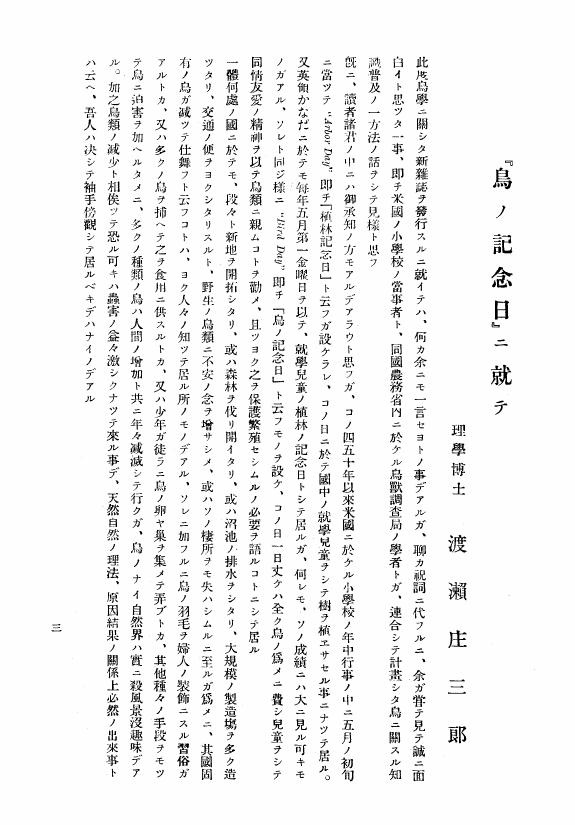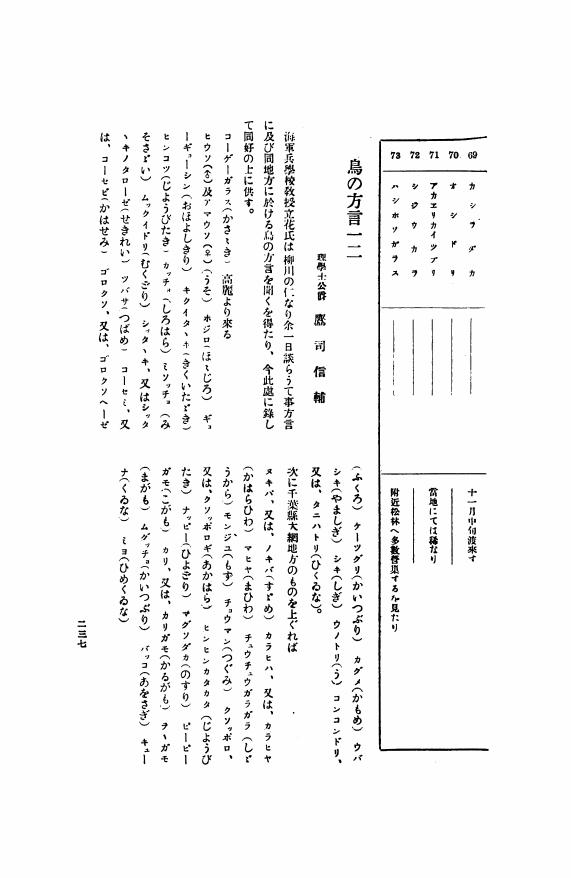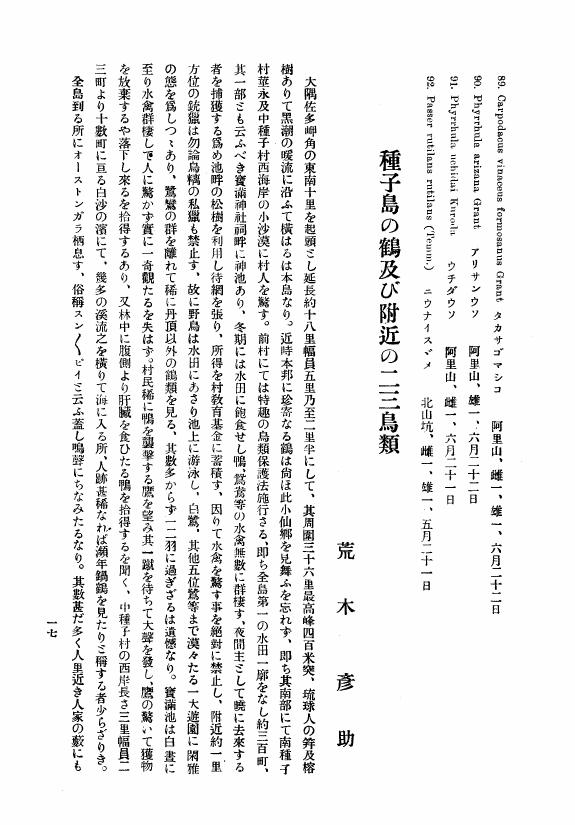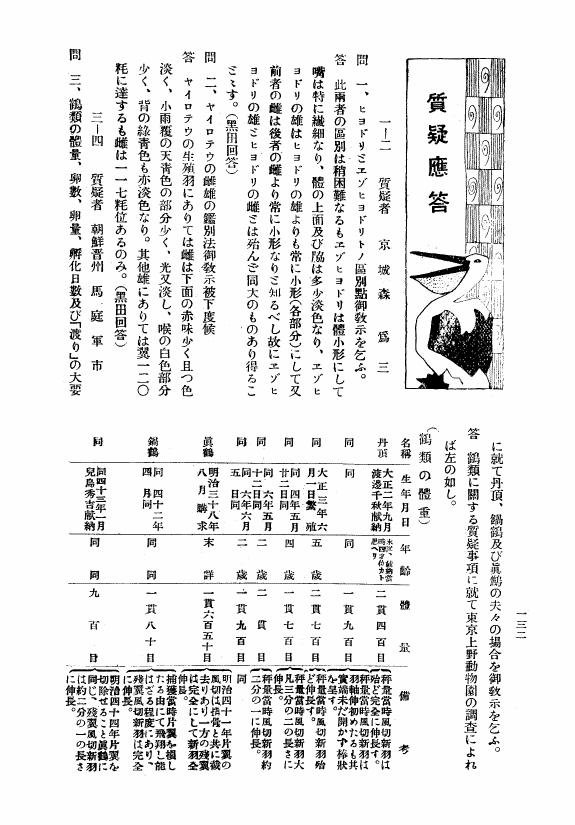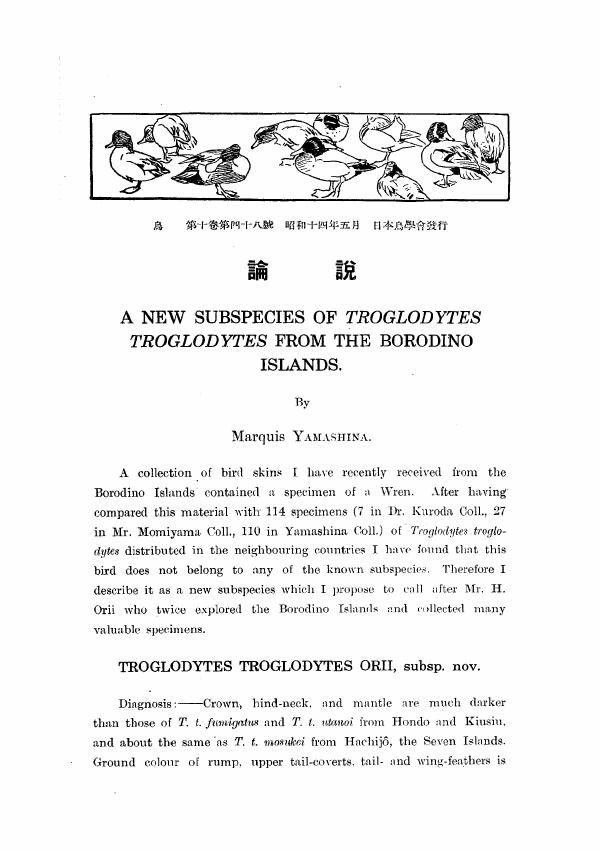22 0 0 0 OA 『鳥ノ記念日』ニ就テ
- 著者
- 渡瀬 庄三郎
- 出版者
- 日本鳥学会
- 雑誌
- 鳥 (ISSN:00409480)
- 巻号頁・発行日
- vol.1, no.1, pp.3-6, 1915-05-26 (Released:2009-02-26)
- 被引用文献数
- 1
9 0 0 0 OA 南大東島のノスリ新亜種について
- 著者
- 黒田 長久
- 出版者
- The Ornithological Society of Japan
- 雑誌
- 鳥 (ISSN:00409480)
- 巻号頁・発行日
- vol.20, no.89, pp.125-129, 1971-06-25 (Released:2008-12-24)
Type: Possibly male, a live specimen at examination on Oct. 22, 1970. Six years and fivemonths old. Collected on May 4, 1964 as new-born chick by Mr. K. Yonamine on Minamidaito I., Borodino Is. and has been reared and being kept alive by Mr. Masao Oshiro in Naha City, Oki-nawa I.Measurements: Total L. 470mm, Wing Exp. 1050mm, Wing 330mm (Natural), 340mm (Pres-sed), Tarsus 64mm, Culmen 31mm (Entire), 24mm (From cere). For comparison, the measurements in 10_??__??_, 6_??__??_ of japonicus (from Japan) are: Wing (Natural) _??__??_ 348-368 (Av. 354. 5)mm, _??__??_ 363-373 (Av. 367. 6)mm; Tail _??__??_ 187-210 (Av. 195.6)mm, _??__??_ 205-210 (Av. 207.5)mm (Measured by the author).Description: Similar to Bnteo buteo japonicus as a whole, but is generally more reddish, the tectrices and rectrices being almost chestnut color with distinct regular dark bands. The sides of head, supercilliaries and ear-coverts, as well as foreneck at crop region are distinctly tawny buff.The typical japonicus is buffy white in these regions, and wings and tail lack chestnut color(though there is a weak wash of this color on primaries) and with less regular dark bands, the tail being usually uniformly pale greyish brown. However, the flank pattern is of japonicus-type (Cf. Photos). There is no similarly reddish and so distinctly banded example among Japanese specimens preserved in Yamashina Institute, and is also different from larger-sized continental reddish and banded phase.Range: Minamidaito I., Borodino Is. (The first record).Remarks: Having examined only one bird, it is not clear whether its plumage pattern represents whole Minamidaito population. However, it is reasonable that a darker (redder) population has been established on this southern island. It is decidedly smaller in size than japonicus. Its subspecific name is dedicated to Mr. Oshiro who has reared it from chick. The nest was found by Mr. Yonamine with three eggs which soon hatched but a late hatched chick had disappeared when he examined the nest three hours later. The two chicks were taken by him and one of them was given to Mr. Oshiro.
9 0 0 0 OA 雪中のマゼランペンギン(上野動物園)(第一圖版)
- 著者
- 時事新報社
- 出版者
- The Ornithological Society of Japan
- 雑誌
- 鳥 (ISSN:00409480)
- 巻号頁・発行日
- vol.8, no.36, pp.Plate1, 1933-05-11 (Released:2008-12-24)
7 0 0 0 OA 鳥類の胸椎数と Notarium の存否について
- 著者
- 鮫島 正道 大塚 閏一
- 出版者
- The Ornithological Society of Japan
- 雑誌
- 鳥 (ISSN:00409480)
- 巻号頁・発行日
- vol.33, no.1, pp.29-38, 1984-08-25 (Released:2007-09-28)
- 参考文献数
- 16
- 被引用文献数
- 1 3
18目42科105属147種(亜種を含む)353個体の日本産および外国産の成鳥と推定した鳥類の晒骨標本を作成し,胸椎について胸椎数とnotariumの形成様式を検索した.(1)胸椎は6-12個と変異に富んでいた.椎骨数は同一科内,同一種内でも変異が大きかった.(2)Notariumは9目12科42種103個体の鳥類に存在した.(3)Notarium の存否,それを形成する胸椎の数や位置,胸椎の synsacrum への参加数は胸椎数と同様に同一科内,同一種内においても変異が大きかった.(4)Notarium は飛翔力の弱いキジ目の全種に存在する一方ゴハト科,ハヤブサ科,ツル科そしてフラミンゴ科などにも存在するので notarium の存否を飛翔と短絡的に関係づけることはできないと推察された.
6 0 0 0 OA 鳳凰とは何か (鸞其他について)
- 著者
- 蜂須賀 正氏
- 出版者
- 日本鳥学会
- 雑誌
- 鳥 (ISSN:00409480)
- 巻号頁・発行日
- vol.4, no.16-17, pp.110-120,PLI, 1924-06-15 (Released:2010-03-01)
4 0 0 0 OA 伊豆諸島と日本主群島南部に棲息するリュウキュウキジバト
- 著者
- 三島 冬嗣
- 出版者
- The Ornithological Society of Japan
- 雑誌
- 鳥 (ISSN:00409480)
- 巻号頁・発行日
- vol.17, no.79-80, pp.218-219, 1962-12-31 (Released:2009-02-26)
伊豆諸島と四国,本州瀬戸内海周辺と琉球諸島に棲息する一連のキジバトは羽毛の色彩に於て普通のS. o. orientalisよりも更に赤味強く濃いと云う共通の特徴による区別があり,筆者はこれらの範囲に分布するこの種S. o. stimpsoniに同定した。分布は確実には次の通りである。伊豆諸島〔三宅島,御蔵島(観察),八丈島,八丈小島,鳥島(漂鳥)〕,四国,本州瀬戸内海周辺〔広島〕,九州,屋久島,奄美大島〔大島,喜界島,徳之島〕,琉球諸島〔伊是名島~与那国島〕。
4 0 0 0 OA 琉球孤島産鳥類の小採集物に就て
- 著者
- 黒田 長禮
- 出版者
- The Ornithological Society of Japan
- 雑誌
- 鳥 (ISSN:00409480)
- 巻号頁・発行日
- vol.5, no.22, pp.79-95, 1926-12-18 (Released:2008-12-24)
4 0 0 0 OA ハシビロコウBalaeniceps rexGould の話
- 著者
- 蜂須賀 正氏
- 出版者
- 日本鳥学会
- 雑誌
- 鳥 (ISSN:00409480)
- 巻号頁・発行日
- vol.4, no.20, pp.375-384, 1925 (Released:2010-03-01)
4 0 0 0 OA 地震に関係するキジの"鳴き"について
- 著者
- 山本 弘
- 出版者
- The Ornithological Society of Japan
- 雑誌
- 鳥 (ISSN:00409480)
- 巻号頁・発行日
- vol.20, no.90, pp.239-242, 1971-12-25 (Released:2008-12-24)
(1) On the occasion of the Tokachi-oki Earthquake (May 17, 1968), a male North Green Pheasant was obsrved in cries reacted to the earthquake in the field.That was at the natural grove in Miyako region, Iwate Prefecture, the seismic intensity was corresponded to IV there, noise by the quake was slight, the pheasant's cries might be heard with every interval about 5 seconds during the definite period of time in distinct quake.Which cring was obviously frequent compared with that of the ordinal habit of him.The every crying was corresponded to the displaying crow, not of the screaming in terror.(2) On the occasion of the Kanto Severe Earthquake (Sept. 1, 1923), Dr. Seiichi KUZU could hear no cries among the many Green Pheasants he had being breeded in Tokyo.(3) On the occasion of a weak earthquake at Sendai City (June 20, 1969), the seismic intensity presumed was about II-III, many glazed windows of a structure gave out violent noise, a male North Green Pheasant, which had been occasionary crowed with very long intervals at the neighbouring bush, began to crow continuously with short intervals were shortened still more in proportionally to the intensification of the windows' noise up to nothing and the crows duplicated each other, and then the crows retrogressed gradually with the noise finally to silence.(4) According to the mentioned facts, the author concluded that the Green Pheasant may reacts against the noise only on the occasion of the earthquake in the male's displaying crow during the breeding season, notwithstanding there had been a firm popular view among the Japanese people that the Green Pheasant screams in terror under the quake of the earth.
4 0 0 0 OA イスカの嘴と舌の作用について
- 著者
- 釜沢 忠夫
- 出版者
- The Ornithological Society of Japan
- 雑誌
- 鳥 (ISSN:00409480)
- 巻号頁・発行日
- vol.14, no.68, pp.52-53, 1957-02-28 (Released:2009-02-26)
The author made a close observation on the mechanism of the bill and the tongue in captive Crossbills, Loxia curvirostra japonica Ridgway. The bill helps the feet in their climing and acrobatic behavior on the branch. To eat pine-cone seeds, the bill half-opened to be not crossed, and they insert it between the scales, closing it to be crossed to push asaid them. The movement of the tongue was also examined closely. It is put out very fast (about 5 times a second) and is pulled back with a pine-cone seed between the 'tip-tongue' and the 'root', i. e. at the notched end of the former; and the 'wing' of the seed is held sideway to be cut off by the bill. The author also reports of their 'hanging-sleep' under pine-tree branch in wild and captive birds.
4 0 0 0 OA 鳥の方言一二
- 著者
- 鷹司 信輔
- 出版者
- 日本鳥学会
- 雑誌
- 鳥 (ISSN:00409480)
- 巻号頁・発行日
- vol.3, no.14, pp.237-237, 1923-03-26 (Released:2010-03-01)
3 0 0 0 OA 北海道紀行
- 著者
- 山階 芳麿
- 出版者
- The Ornithological Society of Japan
- 雑誌
- 鳥 (ISSN:00409480)
- 巻号頁・発行日
- vol.6, no.29, pp.219-242, 1930-04-30 (Released:2008-12-24)
- 被引用文献数
- 2 1
3 0 0 0 OA 種子島の鶴及び附近の二三鳥類
- 著者
- 荒木 彦助
- 出版者
- 日本鳥学会
- 雑誌
- 鳥 (ISSN:00409480)
- 巻号頁・発行日
- vol.2, no.6, pp.17-19, 1918-05-31 (Released:2009-02-26)
3 0 0 0 鳳凰とは何か (鸞其他について)
- 著者
- 蜂須賀 正
- 出版者
- The Ornithological Society of Japan
- 雑誌
- 鳥 (ISSN:00409480)
- 巻号頁・発行日
- vol.4, no.16, pp.110-120,PLI, 1924
2 0 0 0 OA 質疑應答
2 0 0 0 OA 大東列島産ミソサヾイの新亞種(英文)
- 著者
- 山階 芳麿
- 出版者
- The Ornithological Society of Japan
- 雑誌
- 鳥 (ISSN:00409480)
- 巻号頁・発行日
- vol.10, no.48, pp.227-228, 1939-05-30 (Released:2008-12-24)
- 被引用文献数
- 1 1
2 0 0 0 OA 日本産鳥類の分類•分布的研究
- 著者
- 森岡 弘之
- 出版者
- The Ornithological Society of Japan
- 雑誌
- 鳥 (ISSN:00409480)
- 巻号頁・発行日
- vol.28, no.4, pp.125-129, 1979-12-30 (Released:2007-09-28)
- 参考文献数
- 10
- 被引用文献数
- 1 2
Check-list of Japanese Birds (1974) follows VAURIE (1955, 1959) in synonymizing Turdus chrysolaus orii YAMASHINA with nominate chrysolaus. Re-examination of materials, including the type and other specimens from the Kurile Islands, has shown that the breeding males of orii, the northern Kurile population (Paramushir, Araido, Matsuwa), can be separated readily from those of nominate chrysolaus from Sakhalin, Hokkaido and Honshu, on account of the very dark coloration of their head. In this subspecies (breeding males) the head and crown is blackish sooty brown in contrast to the olive-brown nape and back, giving an appearance of being black-capped, whereas in nominate chrysolaus the upper parts are more or less uniform olive brown. The wing length and the bill height (but not bill length) of orii are also larger, although the ranges of variation overlap to some extent between the two forms (Figs. 1-2). It therefore seems to me best to retain orii as a distinct subspecies. In females, juveniles and first winter males orii is rather similar to the nominate form, but in males the characteristics of orii may become recognizable in February or March as the wear of the plumage progresses.
2 0 0 0 OA 福岡縣に現れた珍らしい鳥(其二)
- 著者
- 安部 幸六
- 出版者
- The Ornithological Society of Japan
- 雑誌
- 鳥 (ISSN:00409480)
- 巻号頁・発行日
- vol.12, no.59, pp.274-278, 1949-12-20 (Released:2008-12-24)
Gives detailed account of rare birds captured or observed in Fukuoka Prefecture. Halcyon pileata, Locustella c. ochtensis, Haematopus ostralegus osculans, Synthliborhamphus wumisuzume, Anser fabalis serrirostris, Cygnus cygnus, Gallicrex cinerea, Porzana p. pusilla, Fulica a. atra, Platalea minor, Botaurus s. stellaris, Demigretta sacra ringeri, Podiceps c. cristatus, Nuci fraga caryocalactes japonicus, and an albino Corvus levaillantii japonensis are dealt with.
2 0 0 0 OA 新たに記録される迷鳥3種
- 著者
- 三島 冬嗣
- 出版者
- The Ornithological Society of Japan
- 雑誌
- 鳥 (ISSN:00409480)
- 巻号頁・発行日
- vol.14, no.68, pp.3-5, 1957-02-28 (Released:2008-12-24)
Three species are reported as stragglers with taxonomic notes: Pinicola enucleator kamtschatkensis (Dybowski) new to Sakhalin, Garrulus glandarius orii Kuroda and Muscicapa narcissina jakuschima Hartert of Yakushima to Saitama, Hondo and Muroto, Shikoku respectively.It is to be noticed that some narcissina of Hondo has olivaceous back and the wing-formula of the juvenals is often "Riu Kiu Is. type"! The source of "Seven Is. of lzu (? Hachijo)" for the race jakuschima in the Hand-list, 1942 is two specimens (No. 22. 0182 and 29. 2808) in Momiyama Coll., which the author determined here as narcissina of olivaceous back.
